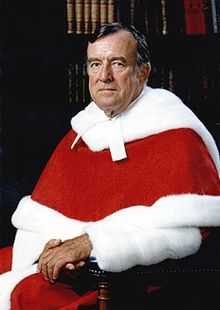Brian Dickson
| The Right Honourable Brian Dickson PC, CC, CD | |
|---|---|
 | |
| 15th Chief Justice of Canada | |
| In office April 18, 1984 – June 30, 1990 | |
| Nominated by | Pierre Trudeau |
| Appointed by | Edward Schreyer |
| Preceded by | Bora Laskin |
| Succeeded by | Antonio Lamer |
| Puisne Justice | |
| In office March 26, 1973 – April 18, 1984 | |
| Nominated by | Pierre Trudeau |
| Preceded by | Douglas Abbott/Emmett Hall/Bora Laskin |
| Succeeded by | Gerald Le Dain |
| Personal details | |
| Born | Robert George Brian Dickson May 25, 1916 Yorkton, Saskatchewan |
| Died | October 17, 1998 (aged 82) Ottawa, Ontario |
Robert George Brian Dickson, PC CC CD (May 25, 1916 – October 17, 1998), commonly known as Brian Dickson, was appointed the 15th Chief Justice of Canada on April 18, 1984. He retired on June 30, 1990 and died October 17, 1998.[1]
Career
Dickson was born to Thomas Dickson and Sarah Elizabeth Gibson, in Yorkton, Saskatchewan, in 1916. Thus his later childhood and young adulthood occurred during the Great Depression and the Dust Bowl years.
The family moved to Winnipeg, where Dickson attended the University of Manitoba after graduating from Ridley College in 1934. As a member of the Zeta Psi fraternity, he graduated with an LL.B in 1938. His first permanent job was with the Great-West Life Assurance Company.
Dickson was called to the bar in 1940, during the Second World War. He subsequently enlisted in the armed forces and served overseas. In August 1944, during a battle near Falaise, Dickson's right leg was hit by friendly fire and had to be amputated.[1]
Upon his return to Winnipeg in 1945, Dickson joined the law firm of Aikins, Loftus, MacAulay, Turner, Thompson & Tritschler and became a successful corporate lawyer. He also lectured at the Faculty of Law of the University of Manitoba for six years, until 1954.
In 1963 he was appointed to the Court of Queen's Bench of Manitoba and in 1967 was elevated to the Manitoba Court of Appeal. He was appointed to the Supreme Court of Canada on March 26, 1973. On April 18, 1984, he was elevated to Chief Justice over the more senior Roland Ritchie. He served on the Supreme Court for 17 years before retiring on June 30, 1990.[1] He died on October 17, 1998, at the age of 82.
Honours
In 1990 Chief Justice Dickson was made a Companion of the Order of Canada.
The library of the University of Ottawa's Faculty of Law is named for him. It contains many of his papers and personal effects.[2]
Judgments
During his early years on the Supreme Court, Dickson was typically known for siding with the opinions of Laskin and Spence, creating a voting bloc that has been known as the "L-S-D connection". [citation needed]
Having come from a corporate law background, Dickson often contributed to the judgements in that field. With the introduction of the Charter in 1982, he made many major contributions to the early standards of interpretation. Among his most famous decisions was that of R. v. Oakes where he first proposed the Oakes test; furthermore, in R. v. Big M Drug Mart he gave a broad interpretation to finding Charter infringement, and in R. v. Morgentaler he found that the prohibition of abortion violated a woman's security of person.
See also
- Robert J. Sharpe and Kent Roach, Brian Dickson: A Judge's Journey (Toronto: The Osgoode Society for Canadian Legal History, 2003).
- Bateman Thomas M.J., Brian Dickson: A Judge's Journey, review
- List of Supreme Court of Canada cases (Dickson Court)
References
- ↑ 1.0 1.1 1.2 "Robert George Brian Dickson". Supreme Court. Government of Canada. 2008-09-04. Retrieved 2009-05-10.
- ↑ "Brian Dickson Law Library". University of Ottawa. 2009-02-23. Retrieved 2009-05-10.
External links
| ||||||||||||||||||||
| ||||||||||||||||||||
|